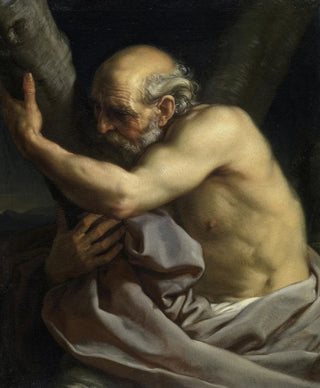Art print | Saint André - Pompeo Batoni


View from behind

Frame (optional)
In the fascinating world of baroque art, the "Saint André" art print by Pompeo Batoni stands out for its ability to capture the very essence of spirituality and majesty. This painting, created in the 18th century, evokes not only the life of the patron saint of fishermen but also a dialogue between the sacred and the profane. Through vibrant colors and carefully orchestrated light, Batoni manages to transport the viewer to a dimension where the divine seems within reach. This art print of "Saint André - Pompeo Batoni" thus allows appreciation of the emotional depth and narrative richness emanating from this iconic work.
Style and uniqueness of the work
Batoni's style is characterized by refined elegance, blending classical and baroque influences. In "Saint André," the treatment of drapery is particularly remarkable. The folds of the saint's garments, rendered with meticulous precision, almost seem to come alive under the effect of light. This technical mastery is accompanied by a palette of warm colors, where golds and reds intertwine to create an atmosphere that is both solemn and soothing. The composition, centered on the figure of the saint, is balanced by a subtly blurred background, thus focusing attention on André's serene face, whose expression conveys deep introspection. This work is not limited to being a simple religious representation; it embodies a true reflection on faith and devotion.
The artist and his influence
Pompeo Batoni, born in Lucca in 1708, is one of the most emblematic painters of the 18th century. His artistic journey was marked by travels across Europe, notably in Rome, where he absorbed the artistic currents of his time. Batoni successfully combined classical tradition with a more modern approach, which allowed him to stand out among his contemporaries. His influence extends beyond religious painting; he also excelled in portraiture, capturing the essence of his models with rare psychological finesse. The way he handles light and shadow, as well as his attention to detail, has inspired many artists who followed.

Matte finish

View from behind

Frame (optional)
In the fascinating world of baroque art, the "Saint André" art print by Pompeo Batoni stands out for its ability to capture the very essence of spirituality and majesty. This painting, created in the 18th century, evokes not only the life of the patron saint of fishermen but also a dialogue between the sacred and the profane. Through vibrant colors and carefully orchestrated light, Batoni manages to transport the viewer to a dimension where the divine seems within reach. This art print of "Saint André - Pompeo Batoni" thus allows appreciation of the emotional depth and narrative richness emanating from this iconic work.
Style and uniqueness of the work
Batoni's style is characterized by refined elegance, blending classical and baroque influences. In "Saint André," the treatment of drapery is particularly remarkable. The folds of the saint's garments, rendered with meticulous precision, almost seem to come alive under the effect of light. This technical mastery is accompanied by a palette of warm colors, where golds and reds intertwine to create an atmosphere that is both solemn and soothing. The composition, centered on the figure of the saint, is balanced by a subtly blurred background, thus focusing attention on André's serene face, whose expression conveys deep introspection. This work is not limited to being a simple religious representation; it embodies a true reflection on faith and devotion.
The artist and his influence
Pompeo Batoni, born in Lucca in 1708, is one of the most emblematic painters of the 18th century. His artistic journey was marked by travels across Europe, notably in Rome, where he absorbed the artistic currents of his time. Batoni successfully combined classical tradition with a more modern approach, which allowed him to stand out among his contemporaries. His influence extends beyond religious painting; he also excelled in portraiture, capturing the essence of his models with rare psychological finesse. The way he handles light and shadow, as well as his attention to detail, has inspired many artists who followed.






